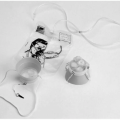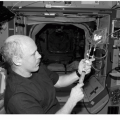Dental Considerations in Aerospace Medicine
William M. Morlang II*
*Dr. Morlang is certified by the American Board of Forensic Odontology. He is a Consultant in Forensic Odontology to the Armed Forces Institute of Pathology. Dr. Morlang is an Adjunct Associate Professor at Tufts University’s School of Dental Medicine. He is a Fellow of the Academies of General Dentistry, Forensic Sciences, the American College of Dentists, the International College of Dentists. Dr. Morlang served in the United States Air Force for thirty years, attaining the rank of Colonel.
“Dentistry’s Growth in the Last Quarter Century has Reached Aerospace Medicine.” Dental practice has changed dramatically over the last 25 years with the current focus being on prevention (1). Additionally, advanced equipment, instrumentation, techniques, and materials have made new options possible when treatment is required. With this growth emerged many subspecialty areas. Aerospace medicine physicians seeking consultation from dental subspecialists, and aviators seeking quality dental care in general, should consider dentists with advanced credentials (Table 20-1).
REACHING AEROSPACE MEDICINE
Dentistry plays two major roles in aerospace medicine. First, dentistry contributes to the aviator’s overall wellness. An aviator’s physical standards must include his or her oral and dental health status. Through timely and appropriate oral and maxillofacial examination and diagnostic radiology, dentists are able to assess an aviator while his or her disease is in an early stage.
To further promote this wellness, a positive and proactive relationship must exist between the aviator, the dentist, and the aerospace medicine physician. This professional relationship, which includes keen professional communications about the aviator, must be fostered by all more aggressively. The dentist and physician must communicate regarding the dentist’s treatment of and medication prescriptions for their mutual patient. The military health care delivery model provides an example for the civilian community to emulate to promote such communication, although the Health Insurance Portability and Accountability Act (HIPAA) has several exceptions for the disclosure of protected health information among covered entities to make such communication usually feasible (2).
Second, forensic odontology often has the lead role in the identification of deceased aviators and other fatalities after aircraft mishaps, particularly so given the destruction of impact forces and associated fires. Genetic identification of human remains can be done using either nuclear or mitochondrial deoxyribonucleic acid (DNA). Nuclear DNA
deteriorates rapidly in an aircraft mishap environment, whereas mitochondrial DNA is more stable and therefore used more frequently for forensic identifications. Forensic dental identification of a deceased is a fraction of the cost compared to DNA identification. It is also weeks to months faster.
deteriorates rapidly in an aircraft mishap environment, whereas mitochondrial DNA is more stable and therefore used more frequently for forensic identifications. Forensic dental identification of a deceased is a fraction of the cost compared to DNA identification. It is also weeks to months faster.
TABLE 20-1 | ||||||||||||||||||||||||||
|---|---|---|---|---|---|---|---|---|---|---|---|---|---|---|---|---|---|---|---|---|---|---|---|---|---|---|
| ||||||||||||||||||||||||||
An invaluable asset to forensic odontology has been the military’s repository for duplicate panoral dental radiographs of its military members. Unfortunately, no new dental radiographs are being added currently to this repository. Instead, United States military members’ DNA is being stored in a repository, believed to now have over 5 million specimens. This author maintains that the military’s dental radiograph repository should be continued.
On the civilian side, it would be prudent for civilian aviators to place a full-mouth dental radiographic series, a fingerprint card, a footprint card, and a dried blood specimen in their private safety deposit boxes. This could be accomplished with the assistance of civilian dentists, medical laboratories, physicians, and law enforcement agencies.
The forensic dental identification process itself is detailed and beyond this chapter’s scope, so it turns now to focus on how dentistry plays a major role in an aviator’s overall wellness.
DENTAL RECORDS
Quality record documentation and sound data management are critical to reliable practice management. They are also allies in malpractice prevention and legal defense at all professional levels. Dental records can be in either paper or electronic format. Electronic format is growing in popularity now because of its ease to incorporate digital dental radiographs.
An aviator’s dental record must be uniquely marked in the dental practice so that all staff know that they are caring for a patient with special requirements. All health care providers must be acutely aware also of aviators who are in sensitive duty programs. Dental records of these persons must also be uniquely marked for recognition. Treatment notification procedures defined in such sensitive duty programs must be followed, without exception.
Quality record documentation enhances proper oral diagnosis, treatment planning, and communication between dentists and aerospace medicine physicians. The United States military services have a straightforward standardization of dental records; however, in civilian practice, a wide diversity of dental forms, charting systems, tooth numbering systems, and abbreviations exists. Attempts, largely driven by the insurance industry, to standardize documentation in civilian dental practice have been only somewhat successful. Nonetheless, an aviator’s dental record should reflect recognized charting methods and symbols, selfintuitive abbreviations, and an accepted tooth numbering system.
Tooth numbering systems are illustrated in most dental anatomy textbooks. The three major systems are Palmer Notation, World Dental Federation Notation of the Fédération Dentaire Internationale (FDI), and Universal Numbering System. The Universal Numbering System assigns each tooth a number, 1 through 32. The sequence begins with tooth number 1—the maxillary right third molar—and continues sequentially around the maxilla to number 16—the maxillary left third molar. The sequence then shifts to the mandibular arch on the left side with tooth number 17—the mandibular left third molar—and continues sequentially around the mandible ending with tooth number 32—the mandibular right third molar. The Universal Numbering System is preferred because it is compatible with the WinID3 forensic identification computer system. WinID3 is presently the premier database program that filters and sorts antemortem and postmortem medical, dental, anthropological, and digital radiographic data to assist in the forensic identification of mass disaster fatalities.
In addition to those elements of charting required by state law, a dentist should be sure to chart the following about aviators: privacy compliance, informed consent, all existing dental restorations, missing teeth, prosthodontic/orthodontic appliances, pathology if noted, treatment plans, treatment delivered, medication prescribed, along with communications with the aviator and aerospace medicine physician. A polished dental practice will also provide the aviator with care instructions delivered both by speaking and in writing.
If time is taken to document in a quality fashion, then similar time should be taken to preserve that important data. Simply stated, backup of electronically stored dental record data is paramount. Further, movement of original dental records into combat zones or otherwise “in harm’s way” should first be considered carefully to protect forensic antemortem data that might be required for postmortem identification. Aviators should not transport their own original dental records on the same aircraft that they are flying.
DENTAL RADIOLOGY
The field of oral and maxillofacial radiology has excelled dramatically in recent years (3). Modern digital dental radiology systems reduce treatment time, provide almost instant results, afford rapid quality review, and reduce radiation exposure.
At a minimum, either a full-mouth series of periapical dental radiographs or a panoral radiograph is essential to have in an aviator’s dental record. The aviator’s record must contain an original radiographic series noted in the preceding text and be augmented with annual bitewing-type radiographs, or as needed, periapical dental radiographs. A new full-mouth radiographic series should be taken every 5 years (or sooner, if significant dental treatment has altered the aviator’s “dental radiographic profile”).
ORAL DIAGNOSIS AND TREATMENT PLANNING
Prevention and proper diagnosis are the keys to superior oral health (4,5). The level of oral examination should be commensurate with the aviator’s indicated physical examination.
An initial and comprehensive type I examination should include a full-mouth radiographic series, an extensive dental examination, a quality periodontal examination, a complete intraoral soft tissue examination, a palpation of appropriate head and neck lymph node sites, a review of the aviator’s current health history and medications, and a blood pressure screening. Follow-up visits after that may include type II or type III examinations. A type II examination substitutes bitewing-type radiographs for the full-mouth radiographic series. A type III examination requires no new radiographs. Necessity for such follow-up is within the dentist’s discretion, unless otherwise required by agency guideline.
At a minimum, the aviator should have at least a type II examination and oral prophylaxis annually. Aviators with histories of significant dental problems should be seen every 6 months. Preventive dental counseling, frequent tooth brushing with fluoride toothpaste, flossing, and fluoridated water consumption are beneficial to maintaining superior oral health (6). Planning for extensive dental treatment for an aviator should be coordinated with his or her aerospace medicine physician before commencement.
Stay updated, free articles. Join our Telegram channel

Full access? Get Clinical Tree







